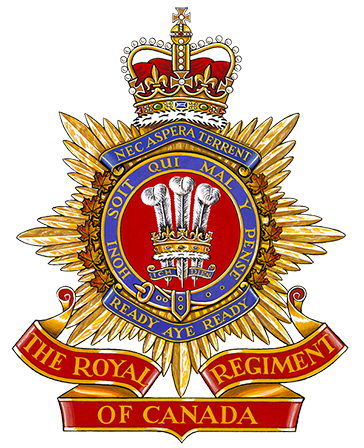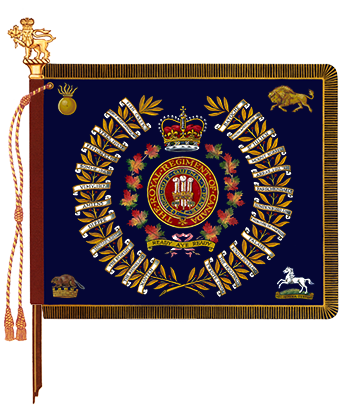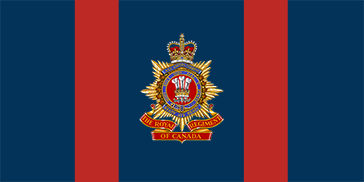The Royal Regiment of Canada
The official lineage of The Royal Regiment of Canada infantry regiment.

Colonel-in-Chief: His Majesty King Charles III, King of Canada
Badge
Description
Gules a coronet of crosses patté and fleurs-de-lis Or jewelled and resting on a band of ermine proper enfiled by three ostrich feathers Argent their tips interlaced with a scroll Azure fimbriated and inscribed ICH DIEN in letters Or, all within a garter Azure fimbriated buckled and inscribed HONI SOIT QUI MAL Y PENSE in letters Or between two scrolls Azure inscribed in chief NEC ASPERA TERRENT and in base READY AYE READY in letters Or environed in the flanks by autumnal maple leaves proper, the whole upon a diamond-cut star Or ensigned by the Royal Crown proper and resting upon a scroll Gules fimbriated and inscribed THE ROYAL REGIMENT OF CANADA in letters Or.
Symbolism
The badge is derived from the badges of The Royal Grenadiers and The Toronto Regiment, which were amalgamated in 1936 to form the regiment. The maple leaves represent service to Canada, and the Crown, service to the Sovereign. The star, a customary infantry badge shape from the 19th century, was taken from the badge of The Royal Grenadiers. The garter, with the motto "HONI SOIT QUI MAL Y PENSE", is that of the Most Noble Order of the Garter.
From The Toronto Regiment was taken the central device. During the Hundred Years' War, Edward the Black Prince, the first Prince of Wales (eldest son of Edward III), defeated the Count of Luxembourg and King of Bohemia (eldest son of the Holy Roman Emperor Henry VII), at the Battle of Crécy. After the battle, the prince adopted the three white ostrich plumes from the crest of his defeated foe as the badge of the heir apparent. He also adopted the dead king's motto "ICH DIEN" (I serve).
"THE ROYAL REGIMENT OF CANADA"" is the regimental title."NEC ASPERA TERRENT", from The Toronto Regiment, and "READY AYE READY", from The Royal Grenadiers, are the mottoes of the regiment. The first motto was taken from their former allied regiment The King's Regiment, now, through amalgamation, the Duke of Lancaster's Regiment.
Motto
READY AYE READY and NEC ASPERA TERRENT (And difficulties do not daunt)
March
"British Grenadiers" followed by "Here's to the Maiden"
Alliance
British Army
Duke of Lancaster's Regiment
Australian Army
The Royal Victoria Regiment
Regimental colour

Camp flag

Battle honours
North West Campaign
FISH CREEK; BATOCHE; NORTH WEST CANADA, 1885.
South African War
SOUTH AFRICA, 1899-1900.
The First World War
YPRES, 1915, '17; Gravenstafel; St. Julien; FESTUBERT, 1915; MOUNT SORREL; SOMME, 1916, '18; Pozières; Flers Courcelette; Ancre Heights; ARRAS, 1917, '18; Vimy, 1917; Arleux; Scarpe, 1917, '18; HILL 70; Passchendaele; AMIENS; Drocourt-Quéant; HINDENBURG LINE; Canal du Nord; Cambrai, 1918; PURSUIT TO MONS; FRANCE AND FLANDERS, 1915-'18.
The Second World War
Dieppe; BOURGUÉBUS RIDGE; Faubourg de Vaucelles; Verrières Ridge-Tilly-la-Campagne; FALAISE; Falaise Road; Clair Tizon; Forêt de la Londe; Dunkirk, 1944; THE SCHELDT; Woensdrecht; South Beveland; THE RHINELAND; Goch Calcar Road; The Hochwald; Xanten; Twente Canal; Groningen; Oldenburg; NORTH WEST EUROPE, 1942, 1944 1945.
South-West Asia
AFGHANISTAN
Lineage
This Reserve Force regiment originated on 14 March 1862 and incorporates the following regiments.
The Royal Regiment of Canada originated in Toronto, Ontario on 14 March 1862, when 'The 10th Battalion Volunteer Militia Rifles, Canada' was authorized to be formed.Footnote 1 It was redesignated: 'The 10th Battalion Volunteer Militia (Infantry), Canada' on 21 November 1862;Footnote 2 'Tenth or "Royal Regiment of Toronto Volunteers"' on 10 April 1863;Footnote 3 '10th Battalion "Royal Grenadiers"' on 5 August 1881;Footnote 4 '10th Regiment "Royal Grenadiers"' on 8 May 1900;Footnote 5 and 'The Royal Grenadiers' on 1 May 1920.Footnote 6 On 15 December 1936, it was amalgamated with 'The Toronto Regiment' (see below) and redesignated 'The Royal Regiment of Toronto Grenadiers'.Footnote 7 It was redesignated: 'The Royal Regiment of Canada' on 11 February 1939;Footnote 8 '2nd Battalion, The Royal Regiment of Canada' on 7 November 1940;Footnote 9 and 'The Royal Regiment of Canada' on 31 December 1945.Footnote 10
Notes:
Upon redesignation as The Royal Grenadiers on 1 May 1920 (see above), it was organized as a three battalion regiment with the 1st Battalion (58th Battalion, CEF) on the Non Permanent Active Militia order of battle and the 2nd Battalion (123rd Battalion, CEF) and 3rd Battalion (198th Battalion, CEF) on the Reserve order of battle.
The Royal Grenadiers were disbanded for the purpose of reorganization on 15 December 1920 and reorganized the same day (GO 30/21). This change was administrative and does not affect the lineage of the regiment.
On 15 June 1926, the 3rd Battalion (198th Battalion, CEF) was deleted from the order of battle (GO 57/26). On 15 December 1926 a new 3rd Battalion (no CEF designation) was authorized to be formed (GO 104/26). The reserve units were disbanded on 14 December 1936 (GO 3/37).
The Royal Grenadiers were disbanded for the purpose of amalgamation on 14 December 1936 and reorganized the next day (GO 223/36). This change was administrative and does not affect the lineage of the regiment.
The Toronto Regiment originated in Toronto, Ontario on 1 May 1920, when 'The Toronto Regiment' was authorized to be formed.Footnote 11 On 15 December 1936, it was amalgamated with The Royal Grenadiers', as above.
Notes:
Upon organization as The Toronto Regiment on 1 May 1920 (see above), it was organized as a four battalion regiment with the 1st Battalion (3rd Battalion, CEF) on the Non Permanent Active Militia order of battle and the 2nd Battalion (124th Battalion, CEF), 3rd Battalion (170th Battalion, CEF), and 4th Battalion (204th Battalion, CEF) on the Reserve order of battle (GO 66/20 and GO 93/20). The reserve units were disbanded on 14 December 1936 (GO 3/37).
The Toronto Regiment was disbanded for the purpose of amalgamation on 14 December 1936 and reorganized the next day (GO 223/36). This change was administrative and does not affect the lineage of the regiment.
Perpetuations
'3rd', '58th', '123rd', '124th', '170th' and '204th "Overseas" Battalion(s), CEF'
Headquarters Location
Toronto, Ontario
Operational history
The Fenian Raids
The Royal Regiment of Toronto Volunteers was called out on active service from 8 to 31 March and from 1 to 22 June 1866. The battalion served on the Niagara frontier.Footnote 12
North West Campaign
The 10th Battalion "Royal Grenadiers" mobilized detachments for active service on 10 April 1885.Footnote 13 The detachments, which served with Middleton's Column of the North West Field Force,Footnote 14 were removed from active service on 24 July 1885.Footnote 15
South African War
The 10th Battalion "Royal Grenadiers" contributed volunteers for the Canadian Contingents during the South African War.Footnote 16
The First World War
Details of the 10th Regiment "Royal Grenadiers" were placed on active service on 6 August 1914 for local protection duties.Footnote 17
The 3rd Battalion, which was authorized on 10 August 1914 as the '3rd Battalion, CEF',Footnote 18 embarked for Great Britain on 26 September 1914.Footnote 19 It disembarked in France on 11 February 1915, where it fought as part of the 1st Infantry Brigade, 1st Canadian Division in France and Flanders until the end of the war.Footnote 20 The battalion was disbanded on 15 September 1920.Footnote 21
The 58th Battalion, which was authorized on 20 April 1915 as the '58th "Overseas" Battalion, CEF',Footnote 22 embarked for Great Britain on 22 November 1915.Footnote 23 It disembarked in France on 22 February 1916, where it fought as part of the 9th Infantry Brigade, 3rd Canadian Division in France and Flanders until the end of the war.Footnote 24 The battalion was disbanded on 15 September 1920.Footnote 25
The 123rd Battalion, which was authorized on 22 December 1915 as the '123rd "Overseas" Battalion, CEF',Footnote 26 embarked for Great Britain on 7 and 8 August 1916.Footnote 27 It was converted to pioneers and redesignated the '123rd Canadian Pioneer Battalion, CEF' on 17 January 1917.Footnote 28 It disembarked in France on 10 March 1917,Footnote 29 where it served as part of the 3rd Canadian Division in France and Flanders until 25 May 1918, when its personnel were absorbed by the '7th', '8th' and '9th Canadian Engineer Battalion, CEF'.Footnote 30 The battalion was disbanded on 15 September 1920.Footnote 31
The 124th Battalion, which was authorized on 22 December 1915 as the '124th "Overseas" Battalion, CEF',Footnote 32 embarked for Great Britain on 7 August 1916.Footnote 33 It was redesignated the '124th Canadian Pioneer Battalion, CEF' on 17 January 1917.Footnote 34 It disembarked in France on 11 March 1917,Footnote 35 where it served as part of the 4th Canadian Division in France and Flanders until 26 May 1918, when its personnel were absorbed by '10th', '11th' and '12th Canadian Engineer Battalion, CEF'.Footnote 36 The battalion was disbanded on 15 September 1920.Footnote 37
The 170th Battalion, which was authorized on 15 July 1916 as the '170th "Overseas" Battalion, CEF',Footnote 38 embarked for Great Britain on 25 October 1916.Footnote 39 On 8 December 1916, its personnel were absorbed by the '169th "Overseas" Battalion, CEF' to provide reinforcements for the Canadian Corps in the field.Footnote 40 The battalion was disbanded on 17 July 1917.Footnote 41
The 204th Battalion, which was authorized on 15 July 1916 as the '204th "Overseas" Battalion, CEF',Footnote 42 embarked for Great Britain on 28 March 1917.Footnote 43 On 4 May 1917, its personnel were absorbed by the '2nd Reserve Battalion, CEF' to provide reinforcements for the Canadian Corps in the field.Footnote 44 The battalion was disbanded on 17 July 1917.Footnote 45
The Second World War
The regiment mobilized the 'The Royal Regiment of Canada, CASF' for active service on 1 September 1939.Footnote 46 It embarked for garrison duty in Iceland with "Z" Force on 10 June 1940,Footnote 47 and on 31 October 1940 it was transferred to Great Britain.Footnote 48 It was redesignated the '1st Battalion, The Royal Regiment of Canada, CASF' on 7 November 1940.Footnote 49 The battalion took part in the raid on Dieppe on 19 August 1942.Footnote 50 It landed again in France on 7 July 1944, as part of the 4th Infantry Brigade, 2nd Canadian Infantry Division, and continued to fight in North-West Europe until the end of the war.Footnote 51 The overseas battalion was disbanded on 31 December 1945.Footnote 52
South-West Asia
From 2002 to 2014, the Royal Regiment of Canada reinforced various CAF units deployed to Afghanistan.Footnote 53